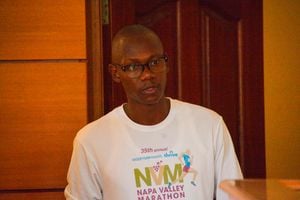So many questions, so many fears: The dilemma of Muslims in Kenya

Muslim leaders led by the Supreme Council of Kenya Muslims Secretary-General Adan Wachu, (centre) addressing the press at the Jamia Mosque on Septmeber 22, 2013 after the Westgate Mall attacks. The Sharawe Report can make a small contribution in helping Kenyans understand the current strength of narratives of injustice and marginalisation that have long characterised local politics.
PHOTO|JENNIFER MUIRURI|FILE.
What you need to know:
- It submitted its final report in March 2008, but Kibaki never released it, and the findings were never publicly discussed or implemented.
- Given the strong narratives of marginalisation and exclusion among many of Kenya’s Muslim communities, and the fact that these grievances are feeding into the radicalisation of a minority, it seems timely to look at the Sharawe Report and pose a number of questions.
Tucked away as an appendix to Volume 2C of the Truth, Justice and Reconciliation Commission’s final report lies a politically pertinent document.
Namely, a leaked copy of the 2008 report of the Presidential Special Action Committee to Address Specific Concerns of the Muslim Community in Regard to Alleged Harassment and/or Discrimination in the Application/Enforcement of the Law.
This committee – let’s call it the Sharawe Committee for short after its chairman A.M. H. Sharawe – was established by President Kibaki in October 2007. It was mandated to “look into and address specific concerns raised by the Muslim community with regard to [their] alleged harassment and/or discrimination in the process of the application of the law particularly as regards to security issues”.
The committee held public hearings in one urban centre in each of the country’s eight provinces; reviewed written memoranda and secondary literature; and consulted public officers, local leaders, and Muslim and human rights organisations.
Like the TJRC, the Sharawe committee suffered from a credibility crisis, and members recognised it was viewed with suspicion as “a stop-gap measure to appease the Muslim community and woo their votes for the then incumbent administration” in the run-up to the 2007 elections.
Still, the committee’s findings are highly critical of the Jomo Kenyatta, Daniel arap Moi, and Kibaki regimes. Its conclusions range from serious abuses suffered by Muslims during state security operations and discriminatory practices in the issuance of national ID cards and passports to problems of regional underdevelopment, the propagation of negative stereotypes in the country’s media, and shortage of Islamic religious education teachers.
Indeed, the committee “found substance in most of the complaints raised by the Muslim community”, and recommended “that the Government urgently address the issues in order to restore public confidence, [and] fully integrate the Muslim community in the mainstream development so as to build national cohesion”.
The committee went on to make specific recommendations on citizenship and registration of persons, security, lands, education, representation and participation, and development and investment.
It submitted its final report in March 2008, but Kibaki never released it, and the findings were never publicly discussed or implemented. Consequently, the report only entered the public domain after it was leaked to TJRC staff and they decided to publish it as an appendix to their own report.
Given the strong narratives of marginalisation and exclusion among many of Kenya’s Muslim communities, and the fact that these grievances are feeding into the radicalisation of a minority, it seems timely to look at the Sharawe Report and pose a number of questions.
Do people agree that Kenya’s Muslims have suffered harassment and discrimination? Have some of the injustices cited been addressed, for example, by the new Constitution and devolution? Have some of them got worse, or have new injustices been added?
Can this history and ongoing experiences of harassment and discrimination help explain, at least in part, the radicalisation of some Kenyan Muslims? And, if so, what can be done to ensure that a sense of marginalisation is not exacerbated, whilst the government simultaneously gathers intelligence and provides security?
Should some of the Committee’s recommendations be implemented? For example, how relevant are recommendations that, “security forces should not target communities for investigations or arrest on the basis [of] religion, ethnicity, race, and origin”; “searches by the security forces should be conducted with due regard to human rights”; and that “Government should develop a Marshal Plan with adequate budgetary provision for predominately Muslim areas to address the historical marginalisation and under-development”?
These are big questions that require thoughtful discussion. Nevertheless, the Sharawe Report can make a small contribution in helping Kenyans understand the current strength of narratives of injustice and marginalisation that have long characterised local politics.
In turn, it seems critical that – rather than politicise the tragic events of the past week – the government do more to win hearts and minds by giving due attention to a documented history of harassment and discrimination.
And that such efforts be complemented by an approach to security and intelligence that helps foster a sense of inclusion among all Kenyans, rather than the ongoing security operations that are in danger of further alienating sections of Kenya’s Muslim communities.





